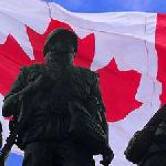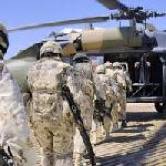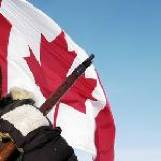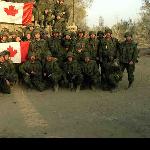by David T. Jones
A long time student of America’s relationship with its northern neighbor looks at the bilateral military relationship as it has evolved over two centuries. Despite some long standing problems within the Canadian defense establishment and in the interaction between the two allies, he remains optimistic as to the future of Canadian Forces and military to military relations with the United States. –Ed.
 Fortunate Canada.
Fortunate Canada.
A country defended on three sides by fish and with a benign neighbor on the fourth.
Or at least a neighbor that regards itself as benign, regardless as what some Canadians may believe.
Canadians say that the world needs more Canada. To be sure, the globe can certainly absorb a substantial number of additional states that are wealthy, technologically advanced, and unthreatening—saying “please” and “thank you” in foreign affairs.
Nevertheless, there are those Canadians—although their ranks may finally be thinning in numbers—who believe that the United States is poised to throw combat units northward and surge across the border to seize Canada’s metropolitan areas and primary natural resources. For them, the stationing of the 10th Mountain Division in Fort Drum, New York, was the tip of the spear rather than an illustration of how then-NY Senator Patrick Moynihan was finally able to rip some base construction funding pork from the southern coalition that overbuilt U.S. bases in Georgia, Alabama, Louisiana, Texas, and the like. But when between 80 to 90 percent of Canadians live within 100-200 miles of the border, such would not be a military feat beyond an “Arctic Storm” campaign plan. And, indeed, there have been military planning exercises deep in the past postulating cross border military action—planning done from both directions.
 If one is seeking 21st century rationales for U.S. military annexation, as well as Albertan oil and natural gas to fuel our economy, Canadian nationalists might now add a fear that we were seeking their precious bodily fluids—or at least their water—to slake the thirst of the ever-more-parched U.S. southwest.
If one is seeking 21st century rationales for U.S. military annexation, as well as Albertan oil and natural gas to fuel our economy, Canadian nationalists might now add a fear that we were seeking their precious bodily fluids—or at least their water—to slake the thirst of the ever-more-parched U.S. southwest.
But such is the stuff of paranoids. And most Canadians dismiss such hypotheses, arguing that if we were able to accept an overtime defeat of our Olympic hockey team without bombing Vancouver, perhaps we will remain content to deal with our bilateral difficulties through negotiation.
A Short Canadian-U. S. History
Canada—following its 1759 absorption into the British Empire after the defeat of the French by General Wolf on the plains of Quebec City—has passed a remarkably unthreatened 250 years. Some of those Canadian nationalists like to recall U.S. cross-border assaults during the Revolutionary War and the War of 1812. But while, indeed, U.S. military forces moved north of the border, they were not attacking “Canada.” Rather they were attacking England, but it was easier to march to Montreal, Quebec City, and Toronto than to London.
The result of the War of 1812 has been a border, which can be labeled the “world’s longest undefended cliché” as that statement seems to be the first factoid discovered by a speechwriter required to provide an illustration of the tranquil nature of our relationship. Upon hearing it delivered, the audience inwardly sighs and hopes that the speaker has something more pertinent to say later in the speech. And while the reality of “undefended” may persist (and remains noteworthy), the reality of the post 9/11 world means that the border may be “undefended” but it is not insecure so far as crossing it is concerned.
 And so far as bearing grudges is concerned, the U.S. has been remarkably nonjudgmental about the British forces that burned Washington in 1814—although some incorrectly believe they were units based in Canada. And we have even less historical memory of the Confederate raiders based in Canada who attacked American towns in Vermont during the Civil War—perhaps balanced by later Fenian raids into Canada. You have to be a somewhat tedious academic to grind through this material searching for material to exploit in the 21st century.
And so far as bearing grudges is concerned, the U.S. has been remarkably nonjudgmental about the British forces that burned Washington in 1814—although some incorrectly believe they were units based in Canada. And we have even less historical memory of the Confederate raiders based in Canada who attacked American towns in Vermont during the Civil War—perhaps balanced by later Fenian raids into Canada. You have to be a somewhat tedious academic to grind through this material searching for material to exploit in the 21st century.
There are a number of historians who argue that Canada became independent in 1867 less through insistent Canadian desire for independence than from British appreciation that a USA, cranky over losses from commerce raiders such as the Alabama, might decide that Canada was appropriate compensation for the Alabama claims. It would have been no more than a short summer campaign for Union forces under Grant/Sherman to annex the key regions of Canada. On the other hand, an independent Canada had a status that a simple colony did not.
During the 20th century, Canadians quite correctly note that the United States was rather dilatory in participating in both World Wars, while Canada was involved immediately. Of course, Canada’s participation was more a consequence of its membership in the British Empire than as a totally independent choice, but in WWI Canadian losses were proportionally greater than U.S. casualties. With a far smaller population, Canadians suffered 39 percent of its mobilized forces as casualties while the U.S. casualty level was 8 percent. And in WWII, Canada put 1 million of its citizens into uniform, mostly as volunteers, from a population of approximately 13 million—taking heavy early casualties at Singapore/Hong Kong against the Japanese and during the abortive raid at Dieppe, France in 1942.
A Canadian army operated in France, sharing the 1944 D-Day landings with British and American forces on its own invasion beach (Juno), and later played a sizeable role in liberating the Netherlands. It operated a heavy bomber fleet, and floated a substantial navy, including forces that played a vital role in defending merchant ship convoys and winning the battle of the North Atlantic.
This was the high point of Canadian military capability. At the end of WWII in 1945, Canada was clearly “punching above its weight” with combat-trained infantry divisions, a “fleet in being,” heavy bombers and fighter squadrons, military industrial production, and even the capability to produce nuclear weapons had it so chosen.
 From that point, however, it was essentially downhill for 60 years. One Canadian observer described Canada’s circumstances as follows: any threat that was large enough to threaten Canada’s sovereignty would be large enough that the USA would have to address it. And, as Canada could never assemble military forces sufficient to defeat a U. S. attack, it could be badly defended at great expense or badly defended at minimal cost. Not heroic, but actuarially cost-effective (and which permitted funding of the Canadian health system and other elements of their social safety net).
From that point, however, it was essentially downhill for 60 years. One Canadian observer described Canada’s circumstances as follows: any threat that was large enough to threaten Canada’s sovereignty would be large enough that the USA would have to address it. And, as Canada could never assemble military forces sufficient to defeat a U. S. attack, it could be badly defended at great expense or badly defended at minimal cost. Not heroic, but actuarially cost-effective (and which permitted funding of the Canadian health system and other elements of their social safety net).
Until its recent commitments in Afghanistan and coincidental modest defense budget increases, the last gurgles of the Canadian military establishment were headed down the drain. Current action has put in a plug, but it will take as long to refill, as it took to empty—even assuming that defense expenditures continue at significant levels.
Ogdensburg Agreement and the PJBD
 Essentially during WWII, the UK passed the baton on the defense of Canada to the United States. The Ogdensburg Agreement epitomized this move, which was the result of an August 1940 meeting between Mackenzie King and Franklin Roosevelt. Both feared that England was in extremis under Nazi attack and new defense arrangements would be vital. The agreement inaugurated closer Canadian-American military cooperation and established the Permanent Joint Board of Defense (PJBD), which became the senior advisory body on continental security. The main purpose of the group is to provide policy-level consultation on bilateral defense matters. Periodically the board conducts studies and reports to the governments of the United States and Canada.
Essentially during WWII, the UK passed the baton on the defense of Canada to the United States. The Ogdensburg Agreement epitomized this move, which was the result of an August 1940 meeting between Mackenzie King and Franklin Roosevelt. Both feared that England was in extremis under Nazi attack and new defense arrangements would be vital. The agreement inaugurated closer Canadian-American military cooperation and established the Permanent Joint Board of Defense (PJBD), which became the senior advisory body on continental security. The main purpose of the group is to provide policy-level consultation on bilateral defense matters. Periodically the board conducts studies and reports to the governments of the United States and Canada.
The Board consists of both Canadian and American military and civilian representatives, with small groups in capitals to support its activities. It is co-chaired by a Canadian and an American, meets semi-annually, alternating between each country and military services, and is composed of diplomatic and military representatives. Its meetings have served as a window on Canada-U.S. defense relations for more almost seven decades during which the Board has served in an important capacity for bilateral military relations and coordination.
The Board has examined virtually every important joint defense measure undertaken since the end of World War II, including construction of the Distant Early Warning of radars, the creation of the North American Air Defense Agreement (NORAD) in 1958, the bi-national operation of the underwater acoustic surveillance system and high-frequency direction finding network, and the decision to proceed with the North American Air Defense Modernization program in 1985.
Nevertheless, one must recognize that the PJBD no longer carries the weight it once did. The first U.S. chairman was Fiorello H. LaGuardia, then mayor of NYC and a significant national political figure. Currently, over a year into the Obama administration, there still is no permanent U. S. chairman, and previous recent U.S. chairmen have been secondary figures. Essentially, it continues more as a totem of the ongoing politico-military relationship than a vital component of it; eliminating the organization would be taken as a negative bilateral “signal” rather than just the rational elimination of an antiquated bureaucratic artifact.
NATO
 Canada has been a NATO member since its inception, joining the U.S. as an illustration of North American solidarity. During the height of the Cold War, Canada fielded a well-regarded combat brigade in Germany (I visited it during the annual “Reforger” NATO maneuvers in the late 1970s) as well as an air squadron, but its military contributions never matched what its GNP indicated it could do. Reflecting this minimalism, all Canadian combat forces were out of Europe by 1991—peace dividend being cashed. Had Canada not participated in the NATO effort in Afghanistan starting in 2001, there could have been a serious argument that the Alliance was no longer relevant for Ottawa—complementing Alliance observation that Canada contributed little at Brussels. As it is, Canada recently spurned NATO’s request to extend its military role in Afghanistan. Today, Canadian interest in and concern for European defense is marginal.
Canada has been a NATO member since its inception, joining the U.S. as an illustration of North American solidarity. During the height of the Cold War, Canada fielded a well-regarded combat brigade in Germany (I visited it during the annual “Reforger” NATO maneuvers in the late 1970s) as well as an air squadron, but its military contributions never matched what its GNP indicated it could do. Reflecting this minimalism, all Canadian combat forces were out of Europe by 1991—peace dividend being cashed. Had Canada not participated in the NATO effort in Afghanistan starting in 2001, there could have been a serious argument that the Alliance was no longer relevant for Ottawa—complementing Alliance observation that Canada contributed little at Brussels. As it is, Canada recently spurned NATO’s request to extend its military role in Afghanistan. Today, Canadian interest in and concern for European defense is marginal.
Defense Industrial Cooperation
A sometimes forgotten element of bilateral civil/military relations is defense industrial cooperation. Just as our industrial cooperation is closely integrated, e.g., auto manufacture, so also is defense production. Canadian firms can bid on U.S. military contracts—and vice versa. A significant portion of the Canadian military equipment inventory is U.S. built.
A problem in recent years has been the U.S. requirement that workers in certain projects pass security clearances, even if not directly engaged in production. This requirement generated privacy concerns for Canada, and has limited some of its defense contract opportunities.
NORAD
U. S. and Canadian military forces have cooperated since 1958 on continental air defense within the framework of the North American Aerospace Defense Command (NORAD). One can argue that the Canadians made a virtue of a necessity; the USA was going to defend itself against any Soviet bomber attack over Canadian air space with or without Canadian agreement. NORAD has given Ottawa a voice in the process.
Administratively, NORAD is a joint command with an American commander and a Canadian deputy. Agreement by national capitals is required for the appointment of the commander/deputy. The military response to the September 11, 2001, terrorist attacks in the United States both tested and strengthened military cooperation between the U.S. and Canada. A new NORAD Agreement that entered into force on May 12, 2006, added a maritime domain awareness component and is of “indefinite duration,” albeit subject to periodic review. The “indefinite” nature of the agreement ends the political reindeer games over renewal that Ottawa tended to play when unhappy with other aspects of the bilateral relationship.
Afghanistan
 Canadian participation as part of the NATO force in Afghanistan has persisted virtually since the beginning of the international effort to remove the Taliban government and rebuild a viable country.
Canadian participation as part of the NATO force in Afghanistan has persisted virtually since the beginning of the international effort to remove the Taliban government and rebuild a viable country.
— Forty members of “Joint Task Force Two” (Canada’s Delta Force equivalent) were deployed in December 2001;
— Regular forces arrived in early 2002 and executed combat missions in the south around Kandahar;
— From 2003-05, Canadian Forces (CF) were stationed in and around Kabul—essentially for local security and rebuilding, with CF levels doubling to 1,200 by end 2005;
— In early 2006, CF transferred to Kandahar–a much tougher mission; a rotating battle group of approximately 2,000 has been engaged in the area every since. In April 2010, there were over 2,800 CF deployed in the entire country—one of the highest force numbers in the Alliance.
— In late 2007, the Canadian government appointed a panel led by former deputy PM John Manley to review circumstances and make recommendations. The result was a conditional commitment to continue combat presence until 2011. In March 2008, PM Harper persuaded Parliament (including the Liberal Party) to endorse continued Canadian Afghanistan commitment until the end of 2011.
— That action took Afghanistan off the table politically during the October 2008 election—much to the unspoken relief of both major parties.
Current circumstances project the departure of CF combat forces by mid-2011 (despite the original intimation that CF would stay until year’s end). Although it has been bruited about that the USG requested Ottawa to extend its combat presence, that does not appear to be the case.
At the annual military Conference of Defense Associations (CDA) March meeting in Ottawa, there was some informal suggestion that a relatively small military training mission might continue. There is an open-ended need for trainers for the Afghan military and Canadians would be well qualified. But that doesn’t seem to be likely either. At the maximum, as noted by Defense Minister Peter MacKay in mid-April, Canadians will continue to mentor the Afghan police—who probably need even more attention than do the Afghan military forces.
Societal ambivalence over the CF
Canadians are proud of their armed forces, but essentially rejected the ambiguous Afghan mission. The fact that 142 soldiers have died during a decade in Afghanistan (which wouldn’t have been wastage in earlier 20th century wars and which one retired CF officer privately commented was less than ski mobile deaths during the same period) has been societal disconcerting for Canada. It raises the question whether Canada could sustain significant combat losses—even among volunteers—regardless of the military challenge.
 Nevertheless, there have been some positives from the Afghanistan mission. Extended numbers of CF have greater operational combat experience, particularly with U.S. forces, and that hasn’t been the case since the Korean War. Our joint exercises and military exchanges have continued and improved.
Nevertheless, there have been some positives from the Afghanistan mission. Extended numbers of CF have greater operational combat experience, particularly with U.S. forces, and that hasn’t been the case since the Korean War. Our joint exercises and military exchanges have continued and improved.
Moreover, Canada has developed—almost by accident—a rather rare capability: trained, experienced, well-equipped light infantry. By some accounts as many as 30,000 CF have cycled through Afghanistan, and while some may be “twofer” and “threefer” soldiers, it is an impressive figure. And there is never enough of that type unit. Think of what a couple of infantry battalions might have accomplished in pre-massacre Rwanda, or in the Sudan/Darfur.
There has been a modest CF renewal. If at the beginning of 2001, the CF were approaching the last gurgle going down the drain, almost 10 years later, there has been a limited but real revival. This circumstance has been spotty, but 9/11 gave impetus to security spending, both under the Liberals as well as the Conservatives.
Since 2006, the Government has initiated a re-equipment effort to rebuild Canadian Forces after the serious defense cuts of the 1990s (termed a “decade of darkness” by a former Chief of the Defense Staff, General Rick Hillier). This program specifically involved the acquisition of equipment (Leopard tanks, artillery, unmanned air vehicles and other systems) to support the mission in Afghanistan. It has also encompassed initiatives to renew certain so-called “core capabilities” (such as the Air Force’s medium range transport aircraft fleet —the C-130— and the army’s truck and armored vehicle fleets). In addition, new capabilities (such as C-17 Globemaster strategic transport aircraft and CH-47 heavy-lift helicopters) have been acquired.
The program of capability renewal was ongoing and projected over the next 20 years aimed to:
· Increase the number of military personnel to 70,000 Regular Forces and 30,000 Reserve Forces;
· Replace the Navy’s current support ships with more capable vessels;
· Build 15 warships to replace existing destroyers and frigates;
· Acquire new Arctic/offshore patrol vessels;
· Replace the current maritime patrol aircraft with 10 to 12 new patrol aircraft;
· Order 65 next-generation fighter aircraft to replace the current fleet of CF-18 fighters;
· Strengthen readiness and operational capabilities; and,
· Improve and modernize defense infrastructure.
But these are the equivalent of pie-in-the-sky projections; getting real hardware will be quite another question, especially with projected spending reductions designed to bring the budget into balance. Indeed, virtually every projected acquisition has either been called into question or substantially delayed, particularly the Navy, which is “celebrating” its 100th birthday but with trepidation rather than positive anticipation for the future.
And some capabilities, such as Canadian submarines, go virtually unmentioned. Following a 2005 accident that cost the life of one submariner, the four-vessel sub fleet was dry-docked for an extended period, and even today, five years later, their operational status is questionable. One report states that none has ever fired a torpedo.
The base line statistics put defense expenditures at $20 billion (16th worldwide); total armed forces (including reserves); 94th; and 58th in active duty personnel.
What Next for Canadian Forces?
 When asked at the CDA in early March by a young CF officer, “What should the CF do next?” CENTCOM Commander David Petraeus noted with some amusement that 30 years in the army had made him smart enough to recognize minefields that he didn’t have to enter.
When asked at the CDA in early March by a young CF officer, “What should the CF do next?” CENTCOM Commander David Petraeus noted with some amusement that 30 years in the army had made him smart enough to recognize minefields that he didn’t have to enter.
Essentially, the basic question for CF is indeed, “What next?” Recently, a senior CF army commander said that come January 2012, the CF could immediately deploy 800 to 2,500 troops for a mission as the government desired. The CF doesn’t need to “rest.” Perhaps. But the technical ability does not assume political willingness. One has the impression that willingness to embrace an ambiguous, open-ended mission would be diminishingly small.
In this regard, one trial balloon (more likely to be a lead balloon) has been for Canada to take command of the UN military mission in Congo. And if Canadians thought the objectives in Afghanistan were far away and ambiguous…
The reality that the army benefited disproportionately from funding attention during the past Afghanistan decade is clearly felt by the other services–the navy in particular. The next several years will demonstrate just how Canada will reshape its forces. But despite budget struggles it is clear that they will continue to coordinate closely with the United States and be technically better able to act as a relevant partner than a decade ago.![]()

David T. Jones is a retired State Department Senior Foreign Service Career Officer and a frequent contributor to American Diplomacy. During a career that spanned over 30 years, he concentrated on politico-military issues, serving inter alia as a POLAD for the Army Chief of Staff. He is coauthor of Uneasy Neighbo(u)rs, a study of American-Canadian bilateral concerns, and has published several hundred articles, columns, and reviews on U.S.-Canadian bilateral issues and general foreign policy.
